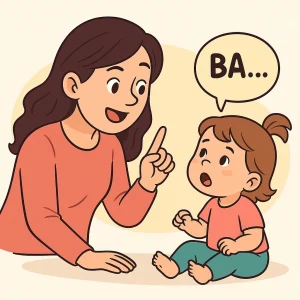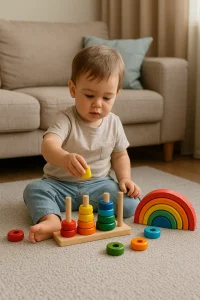Echolalia Communication: Unlocking 10 Powerful Insights
Last Updated: April 23, 2025
Echolalia is a term you may have come across if you’re exploring speech and communication challenges—especially in children. At its core, echolalia refers to the repetition of words or phrases heard from others. While this behavior may seem unusual at first, it’s actually a common part of early language development and can also appear in individuals with conditions such as autism spectrum disorder (ASD), Tourette syndrome, or Alzheimer’s disease.
Understanding echolalia is crucial because it’s more than just mimicry—it can offer insight into how someone processes language, copes with stress, or tries to engage with the world around them. In this article, we’ll explore what echolalia is, why it occurs, how it affects communication, and the strategies that can help manage it effectively, especially in children with autism.
What is Echolalia? Definition and Basics
Echolalia is the repetition or echoing of phrases or sounds that a person hears. It’s often seen in individuals with autism spectrum disorder (ASD), but it can also occur in various other conditions, including Tourette syndrome and Alzheimer’s disease. When someone exhibits echolalia, they might immediately repeat the words spoken to them, or they might repeat them after a delay.
For many, echolalia is a natural part of language development. Young children often use echolalia as they learn to speak by mimicking sounds and words they hear around them. However, when echolalia persists beyond the typical age for such repetition, it may be a sign of a communication disorder.
Also read: What is Echolalia? Why Some Autistic Children Repeat Words
The Role of Echolalia in Communication Disorders
In communication disorders, echolalia isn’t just about mimicry; it’s a complex behavior that can serve multiple functions. For some, it’s a strategy to communicate needs and desires without generating original speech. For others, it can be a method to maintain engagement in a conversation or to buy time as they process what’s been said to them.
However, echolalia can also pose challenges. It can make it difficult for caregivers, educators, and peers to understand whether the person is meaningfully engaged in the conversation or simply repeating sounds. This can lead to misunderstandings and frustrations on both sides. Moreover, reliance on echolalia might inhibit the development of spontaneous and creative language use, which is crucial for effective day-to-day communication.
The Impact of Echolalia on Effective Communication
Echolalia can significantly impact an individual’s ability to communicate effectively, particularly in social interactions and learning environments. Let’s explore how these challenges manifest and what can be done to support those who face them.
Challenges in Social Interactions and Learning
Echolalia presents unique challenges in social settings and learning scenarios. For children and adults with this condition, the repetitive nature of their speech can often be misinterpreted by peers and educators. For instance, a child in the classroom who repeats a question rather than answering it may not be understood by teachers who expect a direct response. This can lead to gaps in learning, as educators might mistakenly assume comprehension or lack thereof.
Moreover, social interactions rely heavily on the give-and-take of conversation. When someone uses echolalia, their responses may seem out of context, making it hard for them to form connections with others. This often leads to social isolation or peer rejection, which can exacerbate feelings of frustration and anxiety, hindering social development further.
Echolalia in Autism: Specific Communication Barriers
In autism, echolalia is often more pronounced and comes with specific barriers. While it can serve as a bridge to communication for some, helping them to initiate interaction when they cannot produce original speech, it also creates significant obstacles. Individuals with autism might use phrases they’ve heard in a favorite video or a past conversation, which may not align with the current social context. This type of communication can confuse listeners who are unfamiliar with the source of the repeated phrases.
Misunderstandings Arising from Repetitive Speech Patterns
The misunderstandings that arise from echolalia are not just confusing but can also lead to incorrect assessments of an individual’s cognitive and emotional states. For example, if a person repeats happy phrases, it doesn’t necessarily mean they feel happy. This can mislead caregivers and therapists, impacting the support and interventions provided.
To address these challenges, it’s essential to observe and understand the intent behind echolalic speech. This understanding can inform tailored strategies that aid in reducing reliance on repetitive speech and encouraging more meaningful exchanges. Techniques might include using prompts that elicit a non-echolalic response or modeling conversations that demonstrate appropriate replies.
Read more about on What is Echolalia? Why Some Autistic Children Repeat Words
Managing Echolalia: Strategies and Approaches
Managing echolalia effectively requires a multifaceted approach, combining speech therapy, behavioral interventions, and supportive tools. Here’s a look at some proven strategies that can help individuals navigate the challenges of echolalia and improve their communication skills.
Speech Therapy Techniques for Echolalia
Speech therapy is pivotal in managing echolalia, focusing on enhancing communication skills by encouraging meaningful speech and reducing repetitive utterances. Here are a few techniques commonly used:
- Delayed Echoing: This involves the therapist pausing before responding to the echolalic speech, encouraging the individual to think about what they are saying and possibly correct themselves.
- Expansion: When a person uses echolalia, therapists often expand on the echoed phrase to build more complex sentences. This not only models more appropriate responses but also aids in language development.
- Mitigation Technique: This strategy helps individuals alter a repeated phrase gradually until it becomes a functional and appropriate response in a conversation.
Behavioral Interventions to Improve Communication
Behavioral interventions are crucial for teaching individuals how to use language more effectively in social interactions. Some effective interventions include:
- Visual Supports: Using images or written words can help guide conversations and provide cues that encourage non-echolalic responses.
- Role-playing: Engaging in role-play scenarios can allow individuals to practice responding in various social contexts, helping them understand how to use language appropriately.
- Positive Reinforcement: Encouraging and rewarding efforts to communicate with original speech can motivate individuals to reduce echolalic responses.
Explore more on Top Positive Reinforcement Methods for Parents
Ten Key Insights into Echolalia and Communication
Echolalia, often misunderstood, plays a complex role in communication disorders. Here, we explore ten critical insights that reveal its multifaceted nature and the advances in managing it effectively.
Insight 1: The Neurological Basis of Echolalia
Echolalia isn’t just a behavioral quirk; it’s rooted in the brain’s neurological functioning. It involves brain regions responsible for language processing and mimicry. Understanding this helps in developing targeted therapies that address these neurological pathways, improving outcomes for those with echolalia.
Insight 2: Echolalia as a Step in Language Development
In young children, echolalia is a natural stage in language development. It helps them learn the rhythm and flow of language, acting as a stepping stone towards fluent speech. Recognizing this can reassure parents and guide them in supporting their child’s growth.
Insight 3: The Coping Mechanism of Echolalia in Stressful Situations
For many, particularly those with autism, echolalia serves as a coping mechanism in stressful or unfamiliar situations. It provides a sense of structure and predictability that can be calming when the world feels overwhelming.
Insight 4: Echolalia’s Role in Learning and Memory
Echolalia can enhance learning and memory by providing a repetitive mechanism through which information is reinforced. This repetition helps to cement new vocabulary and phrases in the memory, aiding in language acquisition.
Insight 5: Differentiating Between Functional and Non-functional Echolalia
Not all echolalia is the same. Functional echolalia serves a communicative purpose, helping individuals express needs or participate in conversations. Non-functional echolalia, however, may not serve a clear communicative function and can be more challenging to address.
Insight 6: The Importance of Timing in Responding to Echolalia
Timing is critical when responding to echolalia. Immediate corrections can frustrate or confuse, while well-timed feedback can encourage learning and self-correction, fostering more effective communication strategies.
Insight 7: How Echolalia Facilitates Language Acquisition in Autism
In individuals with autism, echolalia can be a pivotal part of learning language. It allows them to experiment with sounds and structures, gradually learning to modify echoed phrases into original sentences.
Insight 8: The Potential for Social Interaction Through Echolalia
Echolalia can open doors to social interaction. By echoing phrases, individuals may initiate interactions in their way, and understanding this can help peers and caregivers turn these echoes into meaningful exchanges.
Insight 9: Echolalia in Adult Neurological Conditions
Echolalia is also prevalent in various adult neurological conditions, such as after a stroke or in dementia. Recognizing this can aid in better management and support for affected adults, tailoring interventions to their specific needs.
Insight 10: Advances in Therapy Techniques Targeting Echolalia
The field of speech therapy has seen significant advances in techniques designed to manage echolalia. These include using technology, personalized therapy plans, and new strategies that are more respectful of the individual’s pace and learning style.
Wellness Hub’s Role in Addressing Echolalia
At Wellness Hub, we understand the unique challenges that echolalia presents in communication, and we are dedicated to providing innovative and personalized solutions. Our approach combines cutting-edge speech therapy techniques with supportive resources that empower families and therapists alike.
Innovative Speech Therapy Solutions from Wellness Hub
Wellness Hub is at the forefront of developing innovative speech therapy solutions tailored to address echolalia. We employ a range of modern techniques that are designed to enhance language skills and reduce reliance on repetitive speech. Our methods include:
- Interactive Software Tools: Utilizing technology that interacts dynamically with users, providing real-time feedback that helps modify echolalic patterns.
- Simulation-Based Learning: Offering scenarios that mimic real-life interactions, helping individuals understand and practice appropriate responses in a controlled environment.
- Customized Therapy Programs: Each program is tailored to the individual’s specific needs, focusing on gradually reducing echolalia while enhancing effective communication skills.
Moving Forward with Understanding Echolalia
As we wrap up our exploration of echolalia and its effects on communication, it’s clear that this phenomenon is both complex and deeply impactful. Understanding echolalia is not just about recognizing the repetition of words; it’s about appreciating the underlying needs and challenges associated with it.
Key Takeaways on Echolalia and Communication
Echolalia is more than a communication barrier—it can be a window into how an individual processes and understands language. Here are some crucial takeaways:
- Echolalia as a Learning Tool: For many, especially those with autism, echolalia serves as a stepping stone in language development, aiding in learning the structure and function of language.
- Sign of Underlying Needs: Echolalia often indicates a need for stability in communication or a way to cope with anxiety or stress. Recognizing this can guide more compassionate and effective support.
- Opportunity for Engagement: By understanding the patterns and purposes of echolalia, therapists, educators, and family members can better engage with individuals, transforming echolalic repetitions into meaningful dialogue.
Conclusion
Understanding echolalia goes beyond recognizing repeated words—it’s about connecting deeply with those who experience it. Echolalia can be a learning tool, a sign of underlying needs, or a means to engage more meaningfully. Seeking professional help can significantly enhance communication and coping strategies. At Wellness Hub, we offer tailored support and innovative therapies to meet unique needs. Don’t navigate this journey alone; our dedicated team is here to help. Explore our resources and find the support you need to improve communication and enrich interactions.
Frequently Asked Questions:
1. What is echolalia in simple terms?
Echolalia is when someone repeats words or phrases they hear, often used by individuals learning to communicate or as a way to cope with stress.
2. Why does my child repeat the same words over and over?
Children might repeat words due to echolalia, which is common in developmental stages or can indicate a need for consistency in their communication environment.
3. Is echolalia a sign of autism?
Yes, echolalia is often associated with autism. It’s a way some children with autism learn and use language, though it can also appear in other conditions.
4. How can speech therapy help with echolalia?
Speech therapy can help manage echolalia by teaching more effective communication techniques, helping to expand language use beyond repetitions.
5. What are some simple strategies to reduce echolalia at home?
Engage in direct and meaningful conversations, use clear and simple language, and encourage your child to express their own thoughts.
6. Can echolalia be beneficial for my child?
Yes, echolalia can be beneficial as it helps children learn language structure and can serve as a stepping stone to more complex speech.
7. How do I know if my child’s echolalia is functional or non-functional?
Functional echolalia serves a purpose in communication, like conveying a message or responding in conversation. Non-functional echolalia might seem out of context and not serve an apparent communicative purpose.
8. What should I do if my child uses echolalia in school?
Collaborate with teachers to understand your child’s communication style and explore interventions that support more effective interaction in the classroom.
9. At what age should echolalia stop?
Echolalia typically decreases as a child develops more language skills around the age of 5. If it continues, consider consulting a speech therapist.
10. Where can I find more resources on echolalia?
Check out Wellness Hub’s comprehensive resource center for information and support on managing echolalia, featuring articles, tips, and contact information for professional help.
About the Author:
Shilpa Deshpande
Shilpa Deshpande is a skilled speech-language pathologist with over 14 years of experience. Fluent in Kannada, Telugu, Hindi, and English, she specializes in parent counseling, speech sound disorders, fluency assessment, and speech-language evaluations. Shilpa excels at working with children with developmental disorders, offering creative and effective therapy programs. Currently, at Wellness Hub, she holds a BASLP degree and is registered with the RCI. Her patience, ambition, and dedication make her a trusted expert in her field.
Book your Free Consultation Today
Parent/Caregiver Info:
Client’s Details:
* Error Message








